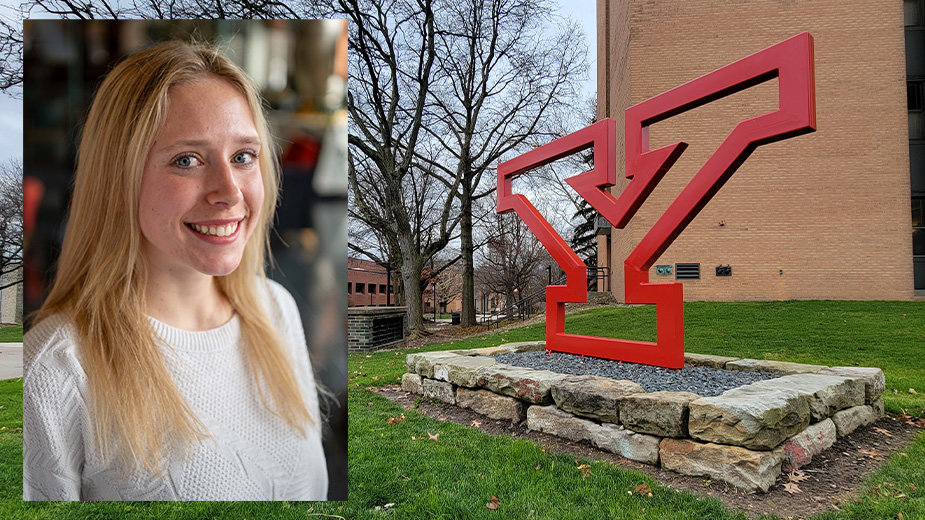Cost of College Concerns Salem High School Students
SALEM, Ohio – A number of Salem High School students say they want to go to college and leave what they describe as a small, historic town that is not reflective of their desires, but financing that dream could be an obstacle.
College tuition costs vary greatly and do not include books, housing, food and supplies. Payment is either per-credit rate or per semester. The average annual tuition costs for a public four-year in-state college is $ 9,970, while the out-of-state yearly rate is $25,620. The average cost of a private college is $34,740, according to StudentDebtRelief.net.
“I think everybody should be concerned about it [cost of college] because it’s such a big thing these days. You go to college for four years and you’re in debt for the rest of your life,” said junior Alex McFarland.
Salem is the first panel of high school students hosted by The Business Journal as part a 15-month program Brain Gain: Building a Culture of Entrepreneurship and Workforce Development.
The student panels are meant to gain a perspective on how young people view the region, what their dreams are whether they will stay or leave the area. Videos for six middle school panels also conducted are being posted in their entirety at BusinessJournalDaily.com/braingainyoungstown. The students were selected by the school for participation in the discussion that was closed to the public.
Salem senior Doug Stiffler said he is foregoing college because of money. He plans to go into law enforcement and is working at a machine shop until he can go into the police academy when he is 21.
Jocelyn Gibson said she is relying on student loans to attend college and become a teacher. “I’m going to apply for student loans, which will make me in debt for the rest of my life for four years of college,” said the junior who has been doing research on college since the sixth grade.
Maddy Workman, sophomore, said she feels like she’s expected to go to college. One of her older sisters who left college after one year is still paying off that debt, according to Workman.
“I guess I’m just relying on athletic scholarships and academic scholarships to try and get me most of the way there and try and figure out the rest,” said Workman who plays softball, volleyball and runs track.
Donald Oesch also pointed to money as being a reason for not going to college, but he also plans to enlist in the Navy.
“I plan on serving for a couple of years and then come back and work at the family business,” said the freshman.
His grandfather owns 21st Century Alarm Data, which builds and installs security systems. He has entrepreneurial leanings and plans to take over the business one day.
Grant Menough plans to go to law school and open his own law firm. To help save for tuition costs, Menough manages a custodial portfolio his parents started for him, he said.
“I have an app on my phone that I can invest the money that I make into different stocks and ETFs,” he said.
An ETF is a public security that trades like a stock and serves a proxy for a group.
Menough works as a busboy Ezio’s Italian Restaurant, mainly on the weekends. He also works at a golf club outside of town and is a lifeguard in the summer. The junior also is commissioned by people in town to do oil paintings of pets, weddings and portraits. He earned national recognition as a freshman for a painting, and recently won gold and silver key awards this year.
“I don’t really enjoy art. I just do it for the money right now,” he said. “I just know I wouldn’t be able to make a living at it if I pursued it.”
McFarland said his mother has put money into a savings account since he was born. “I also have my own job so I can save up from that as well.”
The students said resources exist at the school to assist with career planning, as well as financial and local scholarship information.
Some 44 million Americans owe $1.5 trillion in student-loan debt. College debt is the second-largest debt category behind home mortgages, according to first-quarter 2018 data from the New York Federal Reserve Bank. The average student debt in Ohio is $30,232, ranked 18th nationally, according to a report by The Institute for College Access & Success.
Other students like sophomore Colin Trummer are pursuing trades at the County Career and Technical Center. Trummer said he visited the center for a tour and he wants to pursue landscaping.
“I probably just get something out of college,” he said referring to getting a job.
When he was a freshman, Michael Kidd, now a senior, began pursuing his career as a firefighter. He began taking firefighter classes at Mahoning County Career and Technical Center in the evenings and on weekends through an internship at a local fire department. A Federal Emergency Management Administration (FEMA) grant paid for his schooling as long as he signed a contract to work for a period of time.
“I went the trade route to begin. I heard about it through school announcements. I was the only who took it seriously and I went and checked it out. It worked out because I’ve got my career set,” Kidd said. “I’m working now. I’m a volunteer firefighter for Greene.” said Kidd, who wears a small radio strapped to his belt to alert him in case a call comes in from dispatch.
Max Kemats wants to go away to college in a more urban area.
“I’m not really worried about the financial part. I’m more worried about getting a job after college, said the sophomore who sees himself being a sound producer in the music industry. “I think it’s more my location where I’m at. There’s not many job opportunities for what I want to get into but I’m sure if I moved out of state there’d be more.”
He’s not the only one with that sentiment. The majority of the 12 panelists want to leave the small town founded in 1806.
“I’ve always lived in Ohio and it’s just a culture thing,” Kidd said. “I’ve seen this for my whole life and I want to see what else is out there.”
Many pointed out exploration as a reason for leaving, but most said it was because Salem lacks appeal for younger generations. They contend that job and culture opportunities are fleeting and the downtown needs to be more modern.
“I like the community, but there’s not enough pull factor,” Menough said, explaining pull factor as things that bring new people into the community. “It’s just kind of stale. There’s too many other things out there to go see and not enough to stay in Salem.
McFarland plans to study business administration and management and own a business in the future. What interests him about being an entrepreneur is “the freedom you can really do whatever,” he said. “I think investment in property could be very lucrative. I do plan on leaving.”
He explained that he thinks more opportunities exist outside of Salem, but he may return when he’s older. When asked to define what opportunities meant, he cited his future plans for real estate investment.
“There’s not much property here to invest in. If I buy a lot for development and try to sell, no one wants to buy that property to build a house here,” he said, pointing out that his mom also majored in business and is interested in developing property and they talk about it a lot.
McFarland was asked what would have to happen to spur change.
“Salem would have to change a lot in order to convince younger people to spend the rest of their lives in Salem because there’s a lot that turns younger people away,” he said. “Downtown is dilapidated and falling apart. If you want to spend an evening out on the town there’s nothing to do in Salem. What we mostly do is go to Walmart because that’s the only thing to do in Salem. There’s nothing better than that.”
Several students chimed in agreeing about Salem’s downtown, which is on the historic district register, as being in need of repair.
“It’s like they’re trying to preserve the culture that’s been here,” said Workman. “Those buildings are so old and they want to preserve what life was like back then, but they need to be restored.”
Kemats suggested Salem to become more modern by bringing in more places like Sumo steakhouse and sushi, which opened in the town last year.
Gibson agreed, pointing out that many of the buildings on State Street are run down or falling apart.
When asked how they might play a part in making that happen, McFarland responded, “I think the question is, is that our responsibility or the government’s responsibility? It’s the government’s responsibility to take care of Salem as a whole and to promote and grow business. Businesses set up shop on State Street and they come and leave in less than six months because nobody is going to buy anything downtown is dilapidated.”
He and Gibson referenced EuroGyro that opened last summer and seemed to be doing well until third floor structural problems caused the fire department to close it down for safety in November.
The business owner also owns the building. According to published reports, less than six months after passing inspection, the fire department ordered the business to close for safety after a two-inch gap was found in a corner wall on the third floor. The owner is responsible for hiring a structural engineering firm to make repairs, but EuroGyro remains closed, the Salem News reported.
Despite the criticism, Menough said some revitalization would help, such spray paint or murals on the sides of buildings. He said simple changes like when LED lights on sidewalk replaced older lighting.
“It made a big difference in how people see the downtown, and that’s the heart of the community and it needs to progress with us,” he said.
Kemats said service projects the Key Club takes part in as part of the Kiwanis helps students to explore the town and gets them involved in the community and gives people a reason to want to stay in Salem.
“Really shows anybody can be a leader in the community and it makes you feel good and you make good connections, too,” he said.
Copyright 2024 The Business Journal, Youngstown, Ohio.



